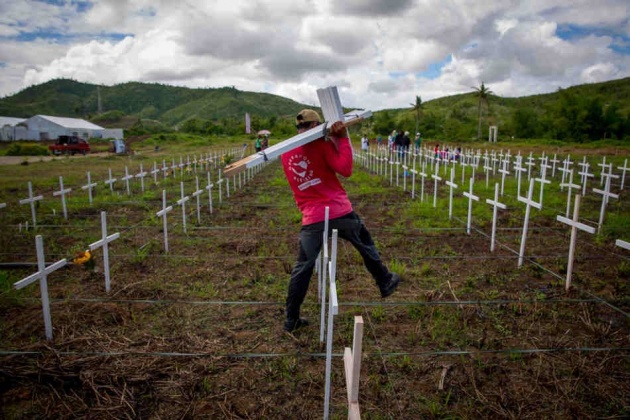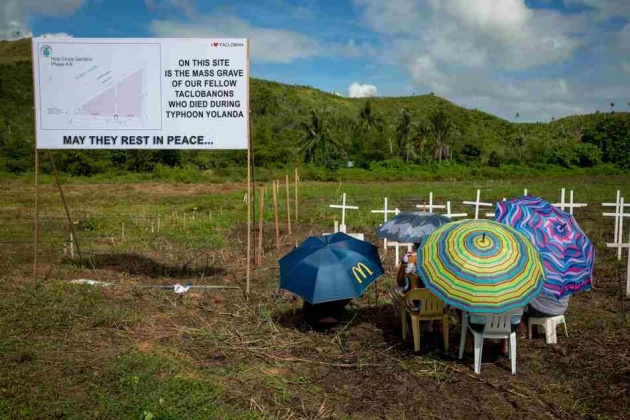
TACLOBAN, LEYTE – Some family and friends of at least 2,000 who perished during super-typhoon Yolanda almost a year ago lit candles and offered prayers Saturday morning before unmarked graves in a cemetery here as city workers and volunteers planted white wooden crosses on plots separated by straw ropes.
Many do not know where their dead actually lay on the 1.2-hectare property bought by the Tacloban city government in the Holy Cross Memorial Garden in Barangay Basper, where 2,764 plots have been contracted for both the identified and unidentified casualties of Yolanda. But some appeared to be comforted by assurances from local authorities that each of the crosses would soon have a number corresponding to the identity of the deceased, resulting from DNA tests performed on bodies found after the Nov. 8, 2013 tragedy.
The formal blessing of the mass grave – to be highlighted by a memorial Mass and offering of flowers – happens next Saturday, exactly a year after Yolanda. But those saying prayers in the cemetery chose to come earlier in keeping with the Filipino tradition of visiting loved ones’ graves on All Saints’ Day, November 1.

For some Taclobanons who survived the tragedy and the loss, remembering the dead is a painful act that came with their efforts to move on from the trauma of losing livelihood, lives and loved ones.
‘Nagbuwis ng buhay si Mama’
One of those struggling to move on is Ralph Dacatimbang, 20, whose mother died when rising water swept away their house in Fatima Village, the junction of Leyte and Samar roads.
Dacatimbang managed to hang on to a wire from an electrical post, with his mother behind his back, and several other neighbors hanging on to her. He said he knew his mother deliberately stopped hanging on to him, and just chose to be swept away.
“Nakita niyang nahihirapan ako. Bumitaw ang Mama, nagbuwis ng buhay,” he said.
His mother’s body was found a week later, far from their house. He tried his best to find decent burial for her, but no one could help him. For a while, he, his brother and sister did what they could to give a semblance of funeral to her. But the overwhelming stench of decaying bodies has been too much. “Ang amoy ng patay nagkalat sa daan; ang aso kumakain na ng patay,” he said. They ended up bringing their mother to the mass grave.
How her mother died and the hardship of events that followed are among painful memories Dacatimbang has been trying to move on from.
He is looking forward to November 8 because by then, he said he learned from authorities, the plots would have numbers, and he would be able to visit his mother on the grave where she actually lies.
For now, he chose to bring white flowers, light white candles and kneel beside one of the nameless plots.
He said he and his siblings decided they will let their mother’s remains stay on this cemetery.

No separate plots, no white crosses
Not everyone is able to look forward to the assurance of their dead being on the exact grave where they have chosen to plant a cross or tombstone on. Not everyone is able to provide a cross or tombstone.
In the mass grave outside the San Joaquin Parish Church, crosses out of wood planks that look like they were fished from the rubble bore names written with marker pens, while sticks held up trampolines or paper posters bearing the fallen’s pictures and messages from relatives and friends.
Papoose Lantajo, chairman of Barangay San Joaquin, Leyte, said families settled with the approximate area where they have laid their loved ones when numerous bodies were being recovered in Palo, Leyte.
Lantajo, 48, lost his father to the super-typhoon, and was only able to recover the body four days after the typhoon's onslaught.
He said he and the parish priest thought of burying the bodies in front of the church where these were collected after being found. A clearance was sought from authorities.
As a result, some plots in the San Joaquin mass grave have even unrelated people together. The graves are marked by signs bearing the enumeration of the names of the deceased who are supposedly buried there.
By Saturday morning, visitors of the San Joaquin mass grave started arriving. After offering flowers, lighting candle and praying, they would clean up wild grass from the grave. Then they would visit other graves and do the same.
Lantajo said there are 371 plots in their mass grave. Many of the dead, he said, were from concrete houses near the church that were downed by the storm surges.
P3K for P35K
There were 2,273 bodies for DNA testing by the National Bureau of Investigation, said Tacloban’s Assistant City Administrator Brando Bernadas. These were bodies found in Tacloban, and have been allotted for in the Holy Cross graves.
The Tacloban City government acquired the plots for a price of P3,000 each, when this would usually go for P35,000 apiece. Bernadas said what is important for the local government is to provide decent burial for the deceased.
In the future, the local government is looking at replacing the wooden crosses with more permanent and lasting markers.
He said for now, what matters is those who have survived Yolanda will be able to remember their dead in a proper burial area.
As of January, government pegged the death toll from the super typhoon at 6, 200, with the majority coming from Eastern Visayas, particularly Leyte.



